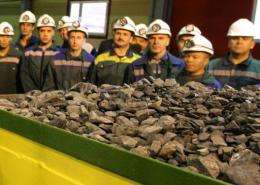Popigai: Russia's vast, untouched diamond crater

In the far north of Siberia, Russian scientists have stepped up research on a once-secret deposit of diamonds whose scale dwarfs anything ever discovered and could turn world markets "upside down".
Soviet scientists had in the 1970s uncovered the 100-kilometre (60-mile) Popigai Crater left by a huge asteroid in Siberia 35 million years ago.
A closer inspection of the dramatic impact zone—lying thousands of kilometres from any city—revealed a fine material that was actually super-compressed diamonds caking the permafrost.
For a long time, the discovery of the diamond deposit was a state secret. It was little publicised after the fall of the Soviet Union when its sheer remoteness—2,000 kilometres from the main Trans-Siberian railway line—made exploitation impossible.
But interest is now picking up thanks to work by the Novosibirsk-based Sobolev Institute of Geology and Mineralogy, which this week gave rare information about the deposit to the media.
The deposit contains not the precious diamonds so adored by brides and monarchs but the industrial strength "impact diamonds" that could be used for deep-sea drilling or forging finely delicate machine parts.
"They (the USSR) discovered it in the 1970s and decided to make it secret," Sobolev Institute of Geology and Mineralogy director Nikolai Pokhilenko told AFP in a telephone interview.
"We were building synthetic diamond plants at the time, so all the natural industrial diamond research was frozen," he explained.
Russian media reports said that Soviet experts had known at the time that the so-called "abrasive" powers of highly-compressed diamonds found in the open were much stronger than those made by synthetic firms.
But the Communist era's logic dictated the promotion of the chemical industry and five-year plans that outlined specific production quotas for everything from synthetic diamonds to bars of soap.
The field was left almost entirely unexplored for the subsequent 30 years.
It was finally declassified in the 1990s at a time of deep economic crisis that prevented any serious production or investment work.
Pokhilenko said the find was then essentially forgotten before his institute picked up its study again three years ago.
"They only examined 0.3 percent of the entire territory of the crater and had already established 147 billion carats worth of (industrial) diamonds. So we are talking about many trillion (carats)," said the scientist.
He noted that by comparison, Russia's main diamond-mining region of Yakutia has known reserves of one billion carats of the precious stones.
That creates the possibility of Russia undercutting the price of the synthetic material now produced in China and delivering a cheap new technology for making machine and airplane parts as well as jewellery work.
"The Popigai Crater diamonds could turn everything upside down. And what happens to prices on this market then is unclear," the Yakutnipromalmaz industrial diamond institute's deputy director Gennady Nikitin said.
But there are also problems linked to accessibility and the sites extreme remoteness from any railways or roads.
"There are production cost-effectiveness issues," leading Sobolev scientist Nikolai Tuchkov admitted.
"It is quite remote from any population centre," he observed.
The deposit sits at the northern end of the border between the vast Siberian regions of Krasnoyarsk and Yakutia—themselves the sizes of small continents—that mostly extend over uninhabited tundra and permafrost.
Tuchkov said that industrial firms that do come out to the region had until now preferred to focus on extracting the region's plentiful minerals that lie somewhat closer to transit points and usable roads.
(c) 2012 AFP



















